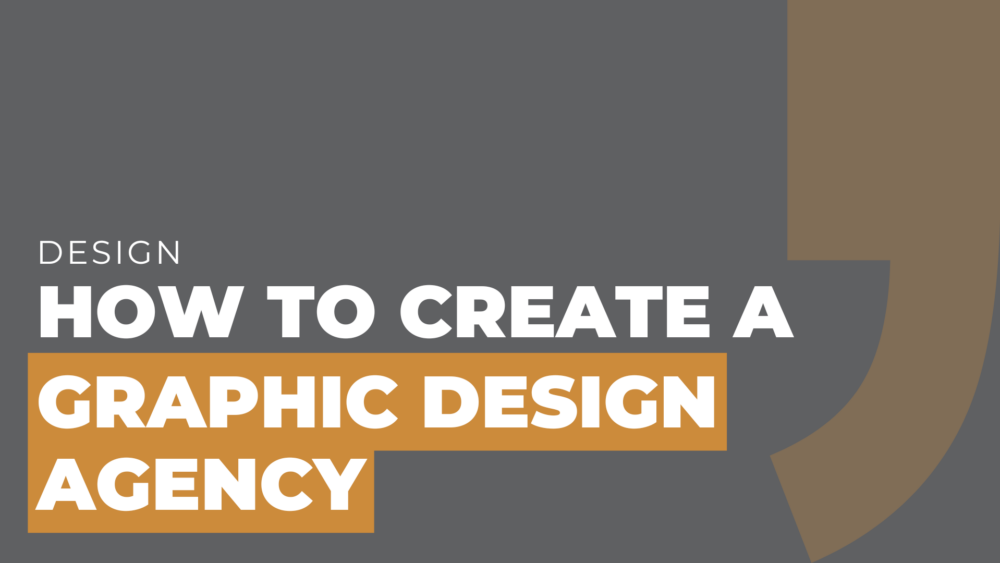Embarking on the journey of building your own graphic design business from scratch can be immensely rewarding, yet daunting.
That why you’re here, right? To find how how to create a graphic design agency.
This process involves much more than just possessing artistic talent.
You will need business acumen, strategic planning, networking skills, and a deep understanding of market dynamics.
As an entrepreneur, you need to define your brand, attract clients, manage business operations, and grow your venture in a competitive landscape.
At MOCK, the Agency, Rob and Don have had a lot of experience learning to set up their own creative agency.
Here we aim to walk you through the fundamentals of starting your own business, from inception to execution, ensuring you are well-equipped to navigate the road ahead.
- Can a graphic design business be a profitable venture?
- Creating and Branding your design agency
- Set Up your graphic design business plan
- What design services will you offer?
- what equipment do you need to start a graphic design business
- What will make you a a successful design company?
- How graphic designers can use social media to help their business succeed
All right, let’s get moving.
Can a graphic design business be a profitable venture?
Absolutely!
Any business, including a graphic design business, has the potential to be profitable.
However, it’s important to understand that starting your own business is a challenging endeavor.
It requires dedication, perseverance, and a willingness to learn from both successes and failures.
Starting your own business is an exciting endeavor, but it also comes with several significant challenges.
Two of the biggest challenges for anyone starting their own business are financial constraints and the fear of failure.
Financial constraints can be a major hurdle when starting a business.
It takes money to make and grow a business, from initial investments in equipment and technology to funding operational expenses and marketing efforts.
Many entrepreneurs face the challenge of securing funding or managing limited resources while trying to turn their vision into a reality.
Make sure you carefully plan and budget, seek out alternative funding options such as loans or grants, and explore cost-effective strategies to make the most of available resources.
Another challenge for business owners is the fear of failure.
Starting a business involves risks, and the fear of not succeeding can be paralyzing.
This fear often stems from the uncertainty of the market, competition, and the ability to generate consistent revenue.
Overcoming this fear requires a resilient mindset and a willingness to learn from failures.
Embracing failure as a learning opportunity and understanding that setbacks are a natural part of the entrepreneurial journey can help entrepreneurs push past their fears and continue moving forward.
Having a support network, seeking mentorship, and surrounding oneself with like-minded individuals can provide encouragement and guidance during challenging times.
Even Google started small, though.

It took at least 10 years for Google to become a household name, and it faced its fair share of challenges along the way.
Yet through determination, innovation, and adaptability, Google became the massive success it is today.
The challenges of building something from the ground up may seem daunting, but they can also serve as catalysts for growth and resilience.
It’s up to you what you want to make it.
Creating and Branding your design agency
While it may be tempting to jump right into picking up clients and projects, taking the time to develop your agency’s identity and brand is a strategic move that can set you apart from competitors and attract the right clients.
Why?
First and foremost, branding your business helps establish a strong and memorable identity.
A well-defined brand creates a cohesive and consistent image that resonates with your target audience.
It communicates your agency’s values, personality, and unique selling points, making it easier for potential clients to understand what sets you apart.
By developing a strong brand, you can differentiate yourself from other graphic design agencies and create a lasting impression in the minds of your clients.
A well-crafted brand also helps build credibility and trust.
Clients are more likely to choose an business that has a professional and polished brand presence.
When your business has a cohesive and visually appealing brand, it signals that you pay attention to detail and take pride in your work.
This can reassure clients that they are working with a reputable and trustworthy business, which can lead to long-term relationships and repeat business.
Furthermore, taking the time to brand your company well allows you to target specific markets and niches.
By understanding your agency’s unique value proposition and target audience, you can tailor your branding efforts to appeal to those specific segments.
This enables you to position your business as an expert in a particular industry or offer specialized services that cater to a specific clientele.
By narrowing your focus and honing your branding, you can attract clients who are seeking exactly what your business has to offer.

Lastly, branding your graphic design business provides a foundation for effective marketing.
Once you have established your design business’s brand, you can leverage it across various marketing channels, such as your website, social media, and promotional materials.
Consistent branding ensures that your messaging is aligned and reinforces your agency’s identity.
It also helps create brand recognition, making it easier for potential clients to recall and refer your business when they are in need of graphic design services.
By investing time and effort into developing a strong brand, you can make your business a more reputable and sought-after player in the industry.
Set Up Your Graphic Design Business Plan
Here are some key components to include when you make your graphic design business plan, along with some commonly overlooked aspects:
Executive Summary
This section provides an overview of your business, including your mission statement, key objectives, and an outline of your services.
This will set the tone and help you make the rest of your business plan.
Having a clear brand identity can also help capture the attention of potential investors or lenders.
Market Analysis
Conduct thorough research on your target market, including your competition, industry trends, and client needs.
Identify your niche and clearly define your target audience.
Highlight your unique value proposition and how you plan to position your business in the market.
Services and Pricing
Clearly outline the range of services you plan to offer as a graphic design business.
Specify the pricing structure for each service, ensuring it aligns with market rates and your desired profit margins.
Don’t forget to include any additional revenue streams, such as selling design templates or providing consulting services.
Marketing and Sales Strategy
Describe how you will market and promote your services to attract clients.
Outline your branding strategy, online and offline marketing channels, and the tactics you will use to reach your target audience.
Include a sales strategy that highlights how you will convert leads into paying clients, such as through a portfolio showcase, networking, or referrals.
Operations and Management:
Detail the operational aspects of your business, including your physical location, equipment and software requirements, and any suppliers or vendors you will work with.
Define the organizational structure of your team, roles and responsibilities, and how you plan to manage and develop your staff.
Financial Projections
Include a realistic financial forecast that outlines your revenue projections, expenses, and anticipated profits over a specific timeframe.
Consider factors such as start-up costs, monthly overheads, and sales targets.
Additionally, include a cash flow statement and break-even analysis to demonstrate the financial viability of your business.
Risk Management
Identify potential risks and challenges your business may face, such as competition, economic downturns, or changing industry trends.
Develop strategies to mitigate these risks and outline contingency plans if unforeseen circumstances arise.
In addition to these sections, it’s important to consider the legal and regulatory aspects of starting a graphic design business.
Make sure that you get necessary licenses or permits and always comply with copyright and intellectual property laws.
Don’t forget to also include a timeline with specific milestones and deadlines to keep your business plan on track.
Remember these elements when you make your business plan, you will have a comprehensive roadmap that sets you up for success and helps you navigate the challenges of starting and growing your business.
What design services will you offer?
Staying Small Vs. Going Big
There are pros and cons to both keeping your list of graphic design services small and offering a broad range of services.

Here are some considerations to help you weigh the options:
Keeping Your List of Design Services Small:
Pros:
Specialization
By focusing on a few select services, you can specialize and become an expert in those areas.
This allows you to hone your skills, deliver exceptional results, and build a reputation as a go-to business for those specific services.
Clients seeking specialized expertise are more likely to choose your business over competitors.
Efficiency and Quality
With a smaller service offering, you can streamline your processes and workflows.
This enables you to work more efficiently, ensuring that each project receives the attention and quality it deserves.
You can dedicate more time and resources to perfecting your craft, resulting in high-quality deliverables that exceed client expectations.
Cons:
Limited Client Reach
Offering a narrow range of services may limit your potential client base.
Some clients prefer one-stop-shop agencies that can handle multiple design needs.
By not providing certain services, you may miss out on opportunities to serve clients who require a broader range of design solutions.
Dependence on Market Demand
Specializing in a specific set of services means that your success is tied to the demand for those services.
If the market experiences shifts or downturns in that particular area, it could impact your business.
Diversifying your services can provide more stability and flexibility in attracting clients across different design needs.
Offering a Broad Range of Services:
Pros:
Increased Client Base
By offering a broad range of design services, you can cater to a wider audience and attract clients with various graphic design needs.
Being a one-stop-shop business can be appealing to clients who prefer convenience and value the simplicity of working with a single business for their diverse design requirements.
Flexibility and Adaptability
In a competitive market, having a broad range of services allows you to adapt to changing trends and client demands.
As graphic design needs evolve, you can easily pivot and offer new services to meet emerging market demands.
This flexibility can help your business stay relevant and competitive.
Cons:
Dilution of Expertise
Offering a wide range of services may result in spreading your resources and skills too thin.
It can be challenging to maintain the same level of specialization and expertise across all areas.
This could potentially impact the quality of your work and reputation if clients perceive you as a jack of all trades but master of none.
Operational Challenges
Managing a broad range of services requires additional resources, such as a larger team and more diverse skill sets.
This can increase operational complexity and might be challenging for a new business with limited resources.
It’s important to ensure that you have the capacity and expertise to deliver high-quality results across all services offered.
Ultimately, the decision to keep your list of design services small or offer a broad range depends on your agency’s specific goals, target audience, resources, and competition in the market.
Finding the right balance that aligns with your strengths and meets the needs of your target clients will help position your business for success.
What equipment do you need to start a graphic design business?
Here is some of the essential equipment to effectively carry out your work.
You should definitely consider:
Computer and Software
A reliable computer with sufficient processing power and storage is a must-have for graphic design work.
Invest in a computer that can handle demanding design software smoothly.
Additionally, you’ll need industry-standard graphic design software such as Adobe Creative Cloud (including Photoshop, Illustrator, and InDesign) or other design tools that meet your specific needs.
High-Quality Monitor
You also need a high-resolution monitor with accurate color reproduction for graphic design work.
This enables you to work with precision and ensure your graphic designs look their best across different devices and mediums.
Consider investing in a calibrated monitor for accurate color representation.
Graphics Tablet
While not mandatory, a graphics tablet can significantly enhance your design workflow.
It allows for more precise and natural drawing and editing, particularly when working with illustration and digital painting.
Choose a tablet that suits your preferences and budget, such as those offered by Wacom or Huion.

Printer and Scanner
Having a printer and scanner can be useful for tasks like creating physical mock-ups, scanning hand-drawn sketches, or digitizing traditional artwork.
Opt for a printer that can produce high-quality prints and a scanner with good resolution for accurate digitization.
Storage and Backup
Invest in reliable storage solutions to safeguard your work.
External hard drives or cloud-based storage services can provide secure backup options for your graphic design files.
Implement regular backup routines to protect your work from data loss or hardware failures.
Office Furniture and Ergonomic Setup
Create a comfortable and ergonomic workspace to support long hours of graphic design work.
Invest in a suitable desk, chair, and lighting that promote good posture and reduce strain on your body.
Consider adding ergonomic accessories like wrist rests and adjustable monitor stands for optimal comfort.
Remember to research and choose equipment that aligns with your specific graphic design needs AND budget.
As technology evolves, staying updated with the latest software versions and hardware advancements will help you deliver high-quality designs and stay competitive in the industry.
What will make you a a successful design company?
Be great at graphic design.
Being excellent at graphic design is indeed a primary key to success for a design company.
Skill and Expertise
Assembling and maintaining a highly skilled team of graphic designers is essential.
As the owner, be sure to hire talented individuals who possess a strong foundation in design principles, creativity, and an eye for detail.
Encourage any and all employees to continue learning and developing as designers to keep up with industry trends and evolving graphic design techniques.
Foster a culture of collaboration, where designers can learn from one another and share knowledge and expertise.
This is how you drive your businesss to consistently deliver high-quality designs that surpass client expectations.
Innovation and Creativity
Excellent graphic design goes beyond technical proficiency; it requires innovation and creativity.
You need your designers to think outside the box, push boundaries, and explore new design possibilities.
Make it a priority to have a creative environment that inspires experimentation and encourages the generation of fresh ideas.
Stay updated on current design trends and seek inspiration from various sources, such as art, architecture, fashion, and technology.
By infusing your work with creativity and innovation, you can create visually compelling and impactful designs that set your company apart from the competition.
Striving for excellence in graphic design not only helps attract clients but also builds a strong reputation for your company.
Be great at business.
Starting a graphic design company requires more than just exceptional design skills.
Many aspiring entrepreneurs in this field often overlook the importance of business acumen and client management.
Here are two key aspects that are often overlooked:
Business Acumen
Running a design business involves various business-related tasks such as financial management, marketing, and strategic planning.
It’s essential to have a solid understanding of these aspects to ensure the agency’s growth and sustainability.
Familiarize yourself with basic accounting principles, budgeting, and pricing strategies to effectively manage finances.
Developing marketing strategies and understanding how to position your design business within the competitive landscape is crucial for attracting clients.
Additionally, honing your project management skills, including timeline management and resource allocation, will help you deliver projects efficiently and maintain client satisfaction.
Client Management
A significant portion of a design business’s success stems from how well you handle clients.
This includes effective communication, understanding client needs, managing expectations, and providing exceptional customer service.
Building strong relationships with clients by actively listening to their feedback and addressing their concerns fosters trust and loyalty.
It’s important to set clear expectations from the outset, make open communication priority, and deliver projects on time and within budget.
It’s really important that you have good negotiation skills and the ability to handle difficult clients or situations.
So be good at design.
And be good at business.
You need BOTH if you’re going to succeed in having your own graphic design business.
How Graphic Designers Can Use Social Media to Help Their Business Succeed
Social media can be an incredibly powerful tool for a new business to not only find clients but also create designs that are tailored for effective social media use.
Here’s how:
Finding Clients
Social media platforms provide an opportunity to showcase your design work and attract potential clients.
You need to make sure that all your social accounts are professional and visually appealing and they reflect your brand identity.
Share your portfolio, case studies, and testimonials to demonstrate your expertise and build trust with your audience.
Use relevant hashtags and engage with industry-specific communities to increase your visibility.
Actively participate in discussions, offer valuable insights, and establish yourself as an authority in the field.
If you consistently share quality content and engage with your target audience, you are more likely to attract potential clients who discover your work through social media channels.
Designing for Social Media
As a graphic design business, offering services specifically tailored for social media can be highly beneficial.
Develop a deep understanding of social media platforms and their design requirements.
Create graphic design templates that clients can use for their social media posts, such as branded templates for Instagram stories or Facebook cover photos.
Provide custom graphics, infographics, and visual assets optimized for various platforms.
Stay updated on current graphic design trends in social media and offer guidance to clients on how they can effectively utilize visual elements to engage their audience.
By providing design solutions that cater to the unique demands of social media, you can add value to your clients’ online presence and make yourself available as a go-to resource for social media design needs.
Leveraging social media platforms both to find clients and create designs that align with the needs of those platforms will really help you.
Your new graphic design business can effectively grow its client base and provide valuable services in the digital landscape.
Continuously adapting to evolving social media trends and staying ahead of the curve will allow you to remain competitive and relevant in this ever-changing industry.
At the End of the Day…
Being successful in the graphic design industry requires a combination of technical skills, creativity, business acumen, and effective use of social media.
By continually pushing boundaries and staying updated on the latest trends and techniques, you can deliver high-quality designs that exceed client expectations.
Equally important is your ability to manage your business efficiently and maintain strong relationships with clients.
Utilizing social media as a tool to find clients and offer specialized design services can also greatly contribute to the growth of your business.
Remember, it’s not just about being great at design or great at business individually – it’s about being both.
So strive for excellence in all aspects of your creative agency.
With determination, hard work, and a strong understanding of all these key aspects, you can facilitate the success of your business.
Here’s to your success!


Comments are closed.